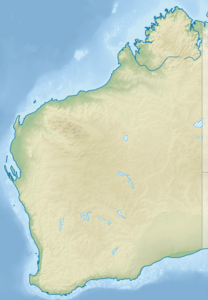Pelsaert Islands
| Pelsaert Islands | ||
|---|---|---|
| NASA landsat image of the Pelsaert Islands | ||
| Waters | Indian Ocean | |
| archipelago | Houtman Abrolhos Archipelago | |
| Geographical location | 28 ° 56 ′ S , 113 ° 55 ′ E | |
|
|
||
| Number of islands | approx. 60 | |
| Main island | Pelsaert Island | |
| Total land area | 2.5 km² | |
| Residents | uninhabited | |
The Pelsaert Islands ( English Pelsaert Group ) are a small group of islands in the Indian Ocean , about 50 km off the coast of Western Australia . They represent the southernmost group in the Houtman-Abrolhos Archipelago and at the same time the southernmost coral reef in the Indian Ocean.
geography
The island area is about 10 km southeast of the Easter Group , the central archipelago in the Houtman-Abrolhos Archipelago, separated by the Zeewijk Channel .
Islands
The group includes, in addition to a large number of reef and small rock formations , u. a. the following islands:
![]() Map with all coordinates: OSM | WikiMap
Map with all coordinates: OSM | WikiMap
Subgroups
Some of the islands to the northeast form the Mangrove Group , including Newman Island and Post Office Island .
Other islands in the west form the subgroup of the Numbered Islands (literally Numbered Islands ), including 1 Island , 2 Island , 3 Island , 7 Island and 8 Island .
history
The name of the archipelago (as well as the main island Pelsaert Island ), which was discovered at the end of the 16th century, was given in honor of François Pelsaert , commander of the Dutch merchant ship Batavia, which sank in 1629 off the reefs of the Wallabi Islands, 10 km to the north . After the Batavia stranded , Pelsaert sailed with a few sailors in a simple lifeboat as far as Jakarta and later returned to the site of the accident to rescue the survivors of the accident. Due to a bloody mutiny in the meantime , however, he found only a few survivors.
On June 9, 1727, another Dutch merchant ship, the " Zeewijk " with a crew of 208 , ran aground in Half Moon Reef on the Pelsaert Islands . Survivors of the accident were able to save themselves on Gun Island and 82 of them reached the original destination of Batavia on April 30, 1728 in a self-built boat (" Sloepie ").
use
Today all islands are uninhabited due to a lack of drinking water sources. To protect fauna and flora, they may only be entered with special permission.
See also
Web links
- NASA image ( memento of December 23, 2010 in the Internet Archive ) in the island encyclopedia www.oceandots.com
- further information and pictures ( memento of July 16, 2011 in the Internet Archive ) in the island encyclopedia www.oceandots.com (English)
- ( Map with all coordinates: OSM | WikiMap )


